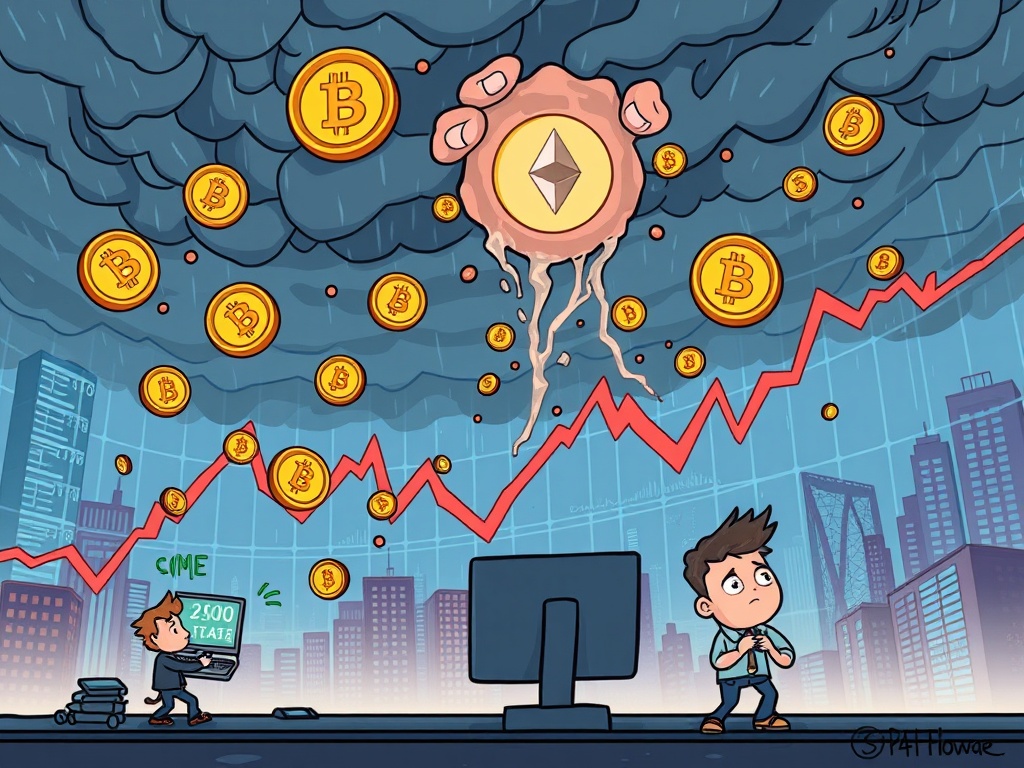BitcoinWorld

Crypto Perpetual Futures Liquidation: Shocking Losses in the Last 24 Hours
The cryptocurrency market is a relentless arena, constantly shifting with dramatic price swings that can make or break fortunes in mere moments. For those deeply immersed in futures trading, one term often sends shivers down the spine: crypto perpetual futures liquidation. It’s the moment when a trader’s leveraged position is forcibly closed due to insufficient margin, leading to significant losses. Over the past 24 hours, the market has once again delivered a stark reminder of this reality, with hundreds of millions of dollars in liquidations across major assets like Bitcoin, Ethereum, and Solana.
What Exactly is Crypto Perpetual Futures Liquidation, and Why Does It Matter?
To truly grasp the gravity of recent market events, it’s crucial to understand the mechanics behind crypto perpetual futures liquidation. Unlike traditional futures contracts that have a fixed expiry date, perpetual futures never expire. This unique feature, combined with leverage, allows traders to amplify their potential gains – but also their potential losses. When a trader opens a leveraged position, they essentially borrow funds to increase their exposure to an asset. However, if the market moves against their position and their margin falls below a certain threshold, the exchange automatically closes their trade to prevent further losses. This forced closure is what we call liquidation. For traders, it represents the complete loss of their initial margin, and for the broader market, it can signal intense selling pressure and heightened volatility.
The Shocking 24-Hour Breakdown: Where Did the Millions Go?
The past 24 hours have painted a vivid picture of the inherent risks in highly leveraged trading, with a staggering amount of capital wiped out through crypto perpetual futures liquidation. Here’s a detailed look at the assets that bore the brunt of this market turbulence:
| Cryptocurrency | Total Liquidated (24H) | Percentage of Long Liquidations |
|---|---|---|
| Ethereum (ETH) | $187.68 million | 87.91% |
| Bitcoin (BTC) | $149.42 million | 94.98% |
| Solana (SOL) | $36.82 million | 93.33% |
As the table clearly illustrates, Ethereum led the pack with nearly $188 million in liquidations, followed closely by Bitcoin at almost $150 million, and Solana contributing over $36 million. What’s particularly striking is the overwhelming percentage of ‘Long’ liquidations across all three assets. A ‘Long’ position profits when the asset price increases. Therefore, a high percentage of long liquidations indicates that the market experienced a significant downward price movement, catching many bullish traders off guard and forcing their positions to close at a loss. This trend suggests a sudden bearish shift or a strong rejection of previous price levels, leading to widespread pain for those betting on an upward trajectory.
Why Did So Many Traders Face Crypto Liquidations? Unpacking the Triggers
The high volume of crypto liquidations in the last 24 hours wasn’t a random occurrence; it was the result of a confluence of factors inherent to the volatile nature of cryptocurrency markets. Understanding these triggers is paramount for any trader hoping to survive and thrive in this environment. Firstly, sudden and sharp price movements are the primary culprits. Crypto markets are notorious for their rapid swings, often without clear warning. A swift dip can quickly push leveraged positions into negative territory, triggering liquidation cascades.
Secondly, excessive leverage plays a critical role. While leverage can magnify profits, it equally amplifies losses. Many traders, especially those new to futures, might over-leverage their positions, leaving very little room for price fluctuations. Even a small adverse move can then lead to a complete wipeout of their margin. Thirdly, the absence of proper risk management, such as setting stop-loss orders, leaves traders vulnerable. A stop-loss order automatically closes a position when the price reaches a pre-defined level, limiting potential losses. Without it, traders are at the mercy of the market, hoping for a reversal that might never come. Finally, broader market sentiment, macroeconomic news, or even specific project-related developments can act as catalysts, leading to panic selling and a surge in liquidation events.
Navigating the Perilous Waters: Actionable Insights for Futures Traders
While the recent wave of crypto perpetual futures liquidation might seem daunting, it offers invaluable lessons for traders. Navigating these turbulent waters requires discipline, knowledge, and a robust risk management strategy. Here are some actionable insights to consider:
- Prioritize Risk Management: This is arguably the most crucial aspect of futures trading. Never risk more than you can afford to lose. Define your maximum acceptable loss per trade and stick to it.
- Understand and Manage Leverage: While high leverage offers enticing returns, it’s a double-edged sword. Start with lower leverage ratios, especially if you’re new to futures. Understand your liquidation price before entering a trade.
- Implement Stop-Loss Orders Religiously: A stop-loss is your best friend in volatile markets. It automatically closes your position at a pre-determined price, preventing catastrophic losses. Don’t rely on manual intervention in fast-moving markets.
- Diversify and Don’t Over-Expose: Avoid putting all your capital into one highly leveraged trade. Diversify your portfolio and manage your overall exposure to the market.
- Stay Informed and Analyze: Keep abreast of market news, technical indicators, and fundamental analysis. Understanding market sentiment and potential catalysts can help you anticipate shifts and adjust your strategies accordingly.
- Emotional Control: Trading under pressure can lead to irrational decisions. Stick to your trading plan and avoid impulsive actions driven by fear or greed.
Beyond the Numbers: The Broader Market Impact of Crypto Liquidations
The sheer volume of crypto liquidations witnessed in the last 24 hours extends far beyond individual trader losses. These events have a ripple effect, influencing broader market sentiment and dynamics. When a large number of leveraged positions are liquidated, it creates significant selling pressure, which can further depress prices. This downward spiral can trigger even more liquidations, creating a cascading effect that intensifies market downturns.
However, it’s not all doom and gloom. Such events also contribute to price discovery, helping the market find true support levels as weak hands are shaken out. They serve as a harsh but necessary reminder of the inherent risks in highly speculative markets and often lead to a healthier, more resilient market in the long run as traders become more cautious and adopt better risk management practices. For seasoned traders, these periods can present opportunities for re-entry at lower prices, but only for those who have preserved capital and maintain a clear, unbiased perspective.
The recent 24-hour breakdown of crypto perpetual futures liquidation serves as a potent reminder of the unforgiving nature of leveraged trading in the volatile cryptocurrency landscape. While the allure of magnified gains is strong, the reality of magnified losses is equally potent. The hundreds of millions wiped out across Bitcoin, Ethereum, and Solana highlight the critical need for robust risk management, disciplined trading, and a deep understanding of market mechanics. For anyone participating in or considering perpetual futures, this data is a stark lesson: knowledge, caution, and a well-defined strategy are your most valuable assets. Stay informed, trade responsibly, and always prioritize capital preservation.
Frequently Asked Questions (FAQs)
1. What is a perpetual future in crypto?
A perpetual future is a type of cryptocurrency derivatives contract that, unlike traditional futures, does not have an expiry date. Traders can hold these positions indefinitely as long as they maintain sufficient margin. They are designed to mimic spot market prices through a funding rate mechanism.
2. How does leverage work in crypto futures trading?
Leverage allows traders to open positions larger than their initial capital. For example, with 10x leverage, a $100 investment can control a $1,000 position. While this amplifies potential profits, it also significantly magnifies potential losses and increases the risk of liquidation.
3. What specifically causes crypto perpetual futures liquidation?
Liquidation occurs when a trader’s leveraged position loses so much value that their margin balance falls below the exchange’s required maintenance margin. This typically happens due to adverse price movements against the trader’s position, especially in highly volatile markets, or if they are over-leveraged.
4. What is the difference between “Long” and “Short” liquidations?
“Long” liquidation happens when a trader who bought a perpetual future (betting on price increase) sees the price drop significantly, leading to their position being closed. “Short” liquidation occurs when a trader who sold a perpetual future (betting on price decrease) sees the price rise significantly, leading to their position being closed.
5. How can traders minimize the risk of crypto perpetual futures liquidation?
To minimize liquidation risk, traders should employ robust risk management strategies. This includes using appropriate leverage (avoiding excessive leverage), consistently setting stop-loss orders to limit potential losses, maintaining sufficient margin, diversifying their portfolio, and staying informed about market conditions.
6. Are perpetual futures safe to trade for beginners?
Perpetual futures trading is highly risky due to leverage and market volatility, making it generally unsuitable for beginners without a thorough understanding of the risks involved. It is advisable for new traders to start with spot trading and gain experience before venturing into derivatives.
Was this breakdown helpful? Share this article with your fellow traders and crypto enthusiasts on social media to spread awareness about the dynamics of crypto perpetual futures liquidation and promote responsible trading practices!
To learn more about the latest crypto market trends, explore our article on key developments shaping Bitcoin, Ethereum, and Solana price action.
This post Crypto Perpetual Futures Liquidation: Shocking Losses in the Last 24 Hours first appeared on BitcoinWorld and is written by Editorial Team





